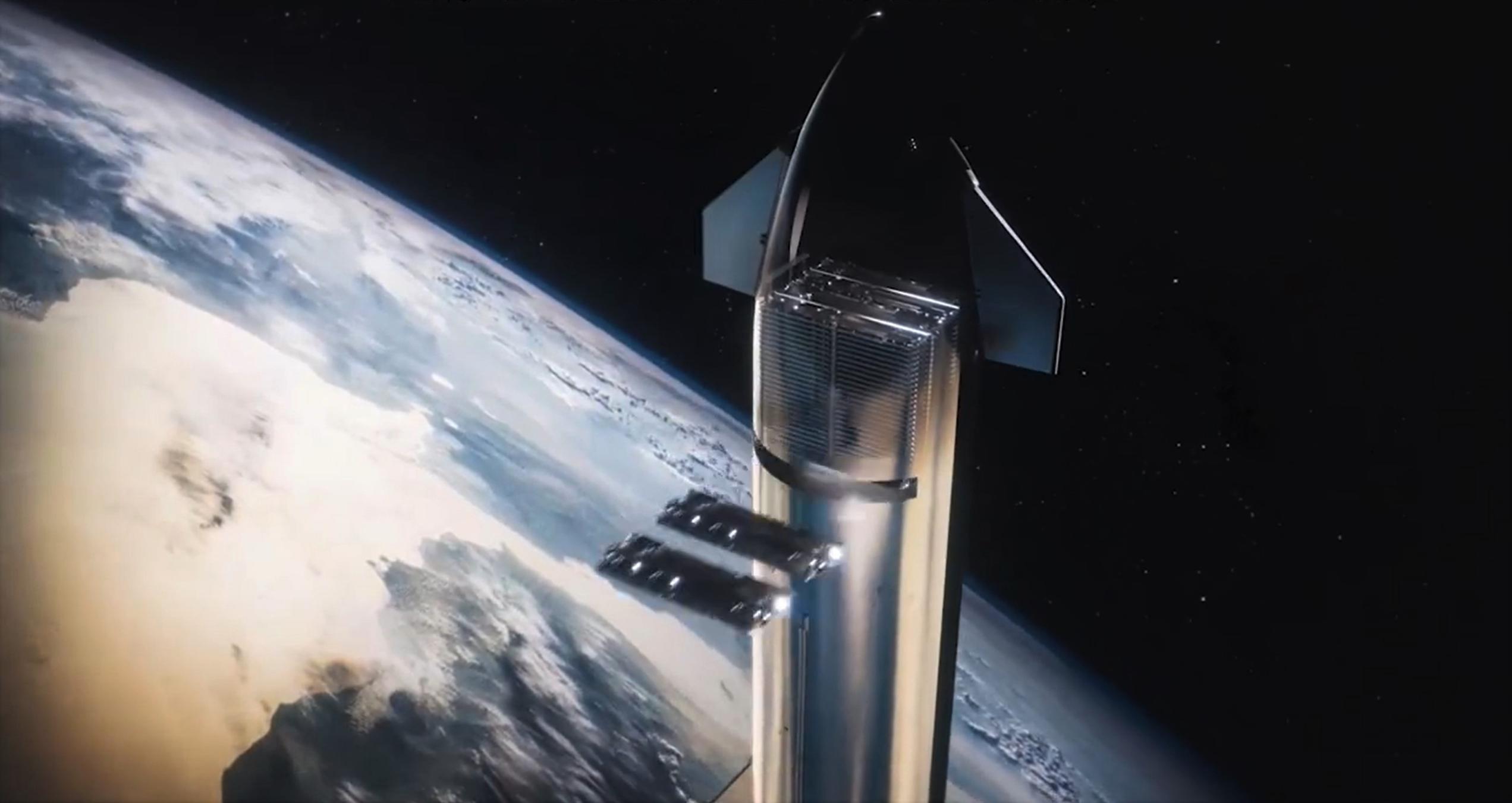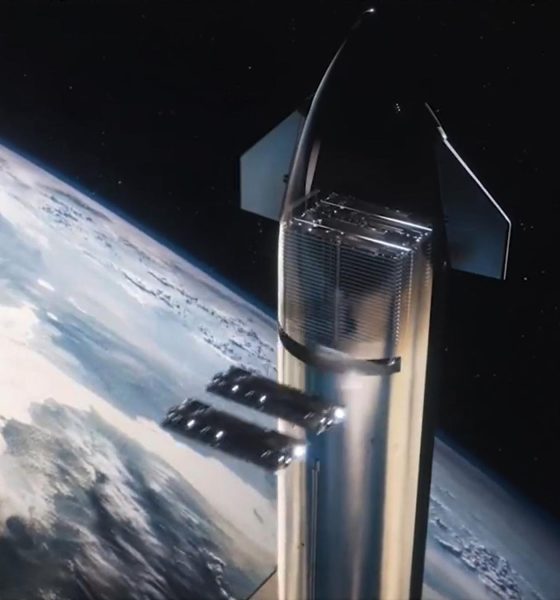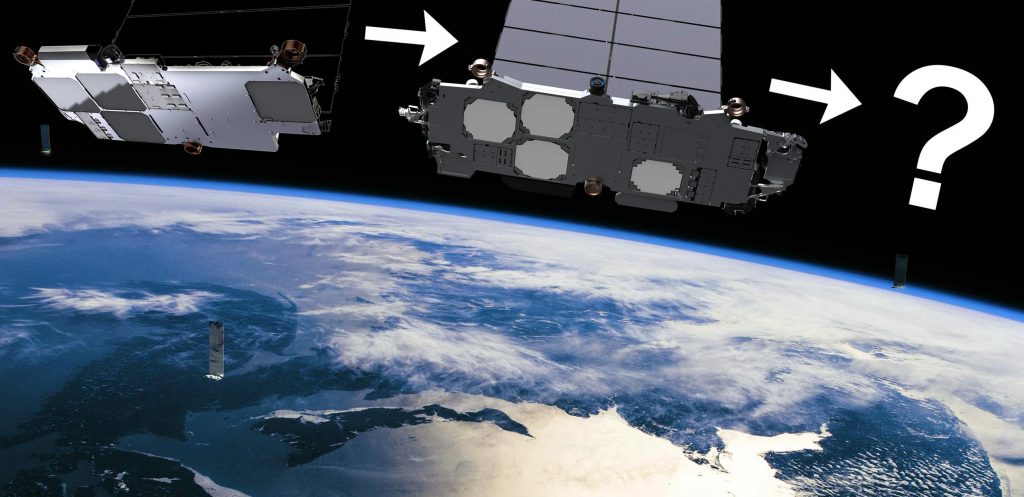

News
SpaceX’s first Starlink V2 satellites spotted at Starbase
On Monday, SpaceX was spotted loading some of the first Starlink V2 satellite prototypes into a custom mechanism designed to refill Starship’s magazine-like payload bay.
While it’s not the first time SpaceX has used the dispenser, the photos captured by photographer Kevin Randolph for the YouTube channel ‘What about it!?’ are the first to clearly show real prototypes of the next generation of Starlink satellites. According to CEO Elon Musk, those Starlink Gen2 or V2 satellites will be “at least 5 times better”, “an order of magnitude more capable,” and about four times heavier than current (V1.5) Starlink satellites.
The potential of the new satellite bus design paired with Starship’s massive fairing and lift capacity could dramatically improve the viability and cost-effectiveness of SpaceX’s Starlink constellation. First, though, the company needs to launch and qualify prototypes of the new satellite design and verify that all associated ground support equipment works as expected.
Due to the designs SpaceX has settled on for both Starlink V2.0 satellites and the Starship hardware that will deploy them in orbit, that ground support equipment and the general path each satellite will take from its arrival at the launch facilities to liftoff on a Starship are wildly different than anything done before. July 18th’s photos (and screenshots from a recent factory tour) confirm that the next-gen satellites are basically enlarged versions of their smaller predecessors, which are also narrow rectangles.
The new spacecraft have a very similar aspect ratio but are around seven meters long and three meters wide (23′ x 10′) instead of approximately 3m x 1.5m (10′ x 5′). They also appear to be about twice as thick and reportedly weigh ~1,250 kilograms to V1.5’s estimated 310 kilograms (~2,750 lb vs ~680 lb). As a result, the V2.0 bus will have about 7-10 times more usable volume than V1.0 and V1.5. It should be no surprise, then, that each next-gen satellite could offer almost magnitude more usable bandwidth.
Assuming that Starship launch costs are roughly the same as Falcon 9 and that Starship can only launch a similar 50-60 satellites at once, an almost 10x performance improvement from a satellite that only weighs five times as much relative to V1.5 would make Starlink V2.0 constellation deployment at least twice as cost-efficient to deploy even if Starship could only launch the same mass (~16 tons) as Falcon 9. In fact, a recent SpaceX render suggests that Starship will be able to carry 54 Starlink V2.0 satellites initially. As a result, even if Starship costs five times more to launch than Falcon 9 (~$75M), it will still be cheaper per unit of bandwidth launched. If Starship eventually reaches marginal launch costs as low as Falcon 9 (~$15M), the cost of Starlink launches (not including satellite cost) could plummet from about $15,000 per gigabit per second (Gbps) to around $1,500-2,500 per Gbps depending on individual satellite bandwidth.
The total cost of the network will be higher, of course, and dependent on more variables, but the combination of Starship and V2.0 satellites could eventually reduce the relative cost of Starlink launch operations by a factor of 5-10. If Starlink V2.0 satellites are actually cheaper to manufacture per unit of throughput than V1.5 satellites, which is not implausible once mass-production begins, those savings will deepen. If Starship can quickly mature and becomes fully and efficiently reusable, the equation could become even more favorable.

Still, loading Starship with satellites is going to be no minor feat and will add a significant amount of complexity and risk relative to the methods SpaceX currently uses for Falcon 9 Starlink launches. SpaceX’s initial Starship payload bay design is a roughly square enclosure that slots just above the ship’s uppermost tank dome and below its inward-curving nosecone. Per a render of the mechanism released last month, it measures about nine meters (30 ft) tall and eight meters (26 ft) wide, can store up to 54 Starlink V2.0 satellites, and dispenses pairs of satellites through a relatively tiny payload bay door that’s only wide enough for the task at hand.
Starship’s airframe is almost exclusively welded together. Once the nosecone and payload bay are installed on top of a ship, the only way to access the interior of the bay is through the dispenser door or an even smaller human-sized access port. SpaceX’s solution: build a mobile satellite storage box that will be lifted by crane (or launch tower arms) dozens to hundreds of feet off the ground and use the payload bay’s own dispenser mechanism in reverse to load satellites like bullets into a giant magazine. If that sounds simple, which it shouldn’t, it’s not.
It’s great, then, to see SpaceX apparently practicing that process with some of the first Starlink V2.0 prototypes. In photos captured on July 18th, workers were spotted loading several satellites into the only existing ‘loader’ inside one of Starbase’s three main factory tents. Each satellite was lifted using a load-spreader device that was presumably required to prevent the extremely long and thin satellites from bending too much in the middle during the lift. It’s unclear whether SpaceX is solely practicing the process or if it’s actually installing satellites well in advance for loading onto a Starship prototype.
Starship S24 is in the middle of preflight testing and has already been greeted by the satellite loader once before, possibly to load a prototype or mockup before ground testing began. Starship S25 appears to be at least a month or two away from completion, though its nose and payload bay section are much closer.

Elon Musk
Tesla’s Elon Musk: 10 billion miles needed for safe Unsupervised FSD
As per the CEO, roughly 10 billion miles of training data are required due to reality’s “super long tail of complexity.”

Tesla CEO Elon Musk has provided an updated estimate for the training data needed to achieve truly safe unsupervised Full Self-Driving (FSD).
As per the CEO, roughly 10 billion miles of training data are required due to reality’s “super long tail of complexity.”
10 billion miles of training data
Musk comment came as a reply to Apple and Rivian alum Paul Beisel, who posted an analysis on X about the gap between tech demonstrations and real-world products. In his post, Beisel highlighted Tesla’s data-driven lead in autonomy, and he also argued that it would not be easy for rivals to become a legitimate competitor to FSD quickly.
“The notion that someone can ‘catch up’ to this problem primarily through simulation and limited on-road exposure strikes me as deeply naive. This is not a demo problem. It is a scale, data, and iteration problem— and Tesla is already far, far down that road while others are just getting started,” Beisel wrote.
Musk responded to Beisel’s post, stating that “Roughly 10 billion miles of training data is needed to achieve safe unsupervised self-driving. Reality has a super long tail of complexity.” This is quite interesting considering that in his Master Plan Part Deux, Elon Musk estimated that worldwide regulatory approval for autonomous driving would require around 6 billion miles.
FSD’s total training miles
As 2025 came to a close, Tesla community members observed that FSD was already nearing 7 billion miles driven, with over 2.5 billion miles being from inner city roads. The 7-billion-mile mark was passed just a few days later. This suggests that Tesla is likely the company today with the most training data for its autonomous driving program.
The difficulties of achieving autonomy were referenced by Elon Musk recently, when he commented on Nvidia’s Alpamayo program. As per Musk, “they will find that it’s easy to get to 99% and then super hard to solve the long tail of the distribution.” These sentiments were echoed by Tesla VP for AI software Ashok Elluswamy, who also noted on X that “the long tail is sooo long, that most people can’t grasp it.”
News
Tesla earns top honors at MotorTrend’s SDV Innovator Awards
MotorTrend’s SDV Awards were presented during CES 2026 in Las Vegas.

Tesla emerged as one of the most recognized automakers at MotorTrend’s 2026 Software-Defined Vehicle (SDV) Innovator Awards.
As could be seen in a press release from the publication, two key Tesla employees were honored for their work on AI, autonomy, and vehicle software. MotorTrend’s SDV Awards were presented during CES 2026 in Las Vegas.
Tesla leaders and engineers recognized
The fourth annual SDV Innovator Awards celebrate pioneers and experts who are pushing the automotive industry deeper into software-driven development. Among the most notable honorees for this year was Ashok Elluswamy, Tesla’s Vice President of AI Software, who received a Pioneer Award for his role in advancing artificial intelligence and autonomy across the company’s vehicle lineup.
Tesla also secured recognition in the Expert category, with Lawson Fulton, a staff Autopilot machine learning engineer, honored for his contributions to Tesla’s driver-assistance and autonomous systems.
Tesla’s software-first strategy
While automakers like General Motors, Ford, and Rivian also received recognition, Tesla’s multiple awards stood out given the company’s outsized role in popularizing software-defined vehicles over the past decade. From frequent OTA updates to its data-driven approach to autonomy, Tesla has consistently treated vehicles as evolving software platforms rather than static products.
This has made Tesla’s vehicles very unique in their respective sectors, as they are arguably the only cars that objectively get better over time. This is especially true for vehicles that are loaded with the company’s Full Self-Driving system, which are getting progressively more intelligent and autonomous over time. The majority of Tesla’s updates to its vehicles are free as well, which is very much appreciated by customers worldwide.
Elon Musk
Judge clears path for Elon Musk’s OpenAI lawsuit to go before a jury
The decision maintains Musk’s claims that OpenAI’s shift toward a for-profit structure violated early assurances made to him as a co-founder.

A U.S. judge has ruled that Elon Musk’s lawsuit accusing OpenAI of abandoning its founding nonprofit mission can proceed to a jury trial.
The decision maintains Musk’s claims that OpenAI’s shift toward a for-profit structure violated early assurances made to him as a co-founder. These claims are directly opposed by OpenAI.
Judge says disputed facts warrant a trial
At a hearing in Oakland, U.S. District Judge Yvonne Gonzalez Rogers stated that there was “plenty of evidence” suggesting that OpenAI leaders had promised that the organization’s original nonprofit structure would be maintained. She ruled that those disputed facts should be evaluated by a jury at a trial in March rather than decided by the court at this stage, as noted in a Reuters report.
Musk helped co-found OpenAI in 2015 but left the organization in 2018. In his lawsuit, he argued that he contributed roughly $38 million, or about 60% of OpenAI’s early funding, based on assurances that the company would remain a nonprofit dedicated to the public benefit. He is seeking unspecified monetary damages tied to what he describes as “ill-gotten gains.”
OpenAI, however, has repeatedly rejected Musk’s allegations. The company has stated that Musk’s claims were baseless and part of a pattern of harassment.
Rivalries and Microsoft ties
The case unfolds against the backdrop of intensifying competition in generative artificial intelligence. Musk now runs xAI, whose Grok chatbot competes directly with OpenAI’s flagship ChatGPT. OpenAI has argued that Musk is a frustrated commercial rival who is simply attempting to slow down a market leader.
The lawsuit also names Microsoft as a defendant, citing its multibillion-dollar partnerships with OpenAI. Microsoft has urged the court to dismiss the claims against it, arguing there is no evidence it aided or abetted any alleged misconduct. Lawyers for OpenAI have also pushed for the case to be thrown out, claiming that Musk failed to show sufficient factual basis for claims such as fraud and breach of contract.
Judge Gonzalez Rogers, however, declined to end the case at this stage, noting that a jury would also need to consider whether Musk filed the lawsuit within the applicable statute of limitations. Still, the dispute between Elon Musk and OpenAI is now headed for a high-profile jury trial in the coming months.








